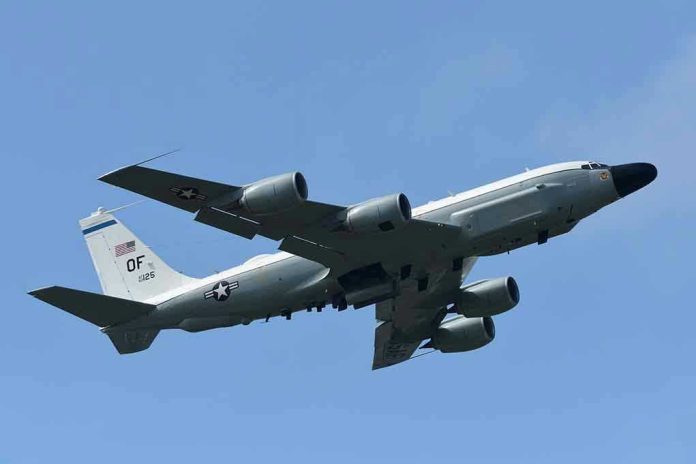
When the U.S. Secretary of Defense’s plane suddenly plunged toward 10,000 feet over the Atlantic, it wasn’t enemy fire or espionage—just a cracked windshield threatening to shatter the illusion of invincibility that surrounds America’s most powerful leaders.
Story Snapshot
- Pete Hegseth’s flight from Brussels to the U.S. made an emergency landing in the UK after a windshield crack forced instant action.
- All passengers, including Hegseth, landed safely at RAF Mildenhall following precisely executed safety protocols.
- The event spotlights the aging U.S. government aircraft fleet and the critical importance of maintenance for high-profile flights.
- Swift, calm response averted disaster and reinforced confidence in emergency procedures for national leaders.
When the Shield Cracks: High-Stakes Emergency at 30,000 Feet
Pete Hegseth’s return from a tense NATO Defense Ministers meeting in Brussels took an unscripted turn. As the C-32A—an aircraft more accustomed to diplomatic missions than mechanical drama—soared over the Atlantic, a crack appeared in the cockpit windshield. With every second, the risk of catastrophic decompression grew. Pilots wasted no time, executing a rapid descent to 10,000 feet. This altitude, just high enough to keep everyone breathing safely but low enough to avoid explosive pressure changes, is standard protocol in such emergencies. RAF Mildenhall, a strategic U.S. Air Force base in the UK, became the unlikely stage for their emergency landing. Passengers, including the Secretary himself, emerged unharmed, the flight crew’s professionalism turning a potential tragedy into little more than a travel hiccup.
This episode didn’t just test nerves; it tested the systems built to protect America’s leaders, raising urgent questions about the hardware trusted with their lives.
Behind the Glass: The Aging Arsenal of U.S. Government Aircraft
The C-32A, a modified Boeing 757-200, is no stranger to ferrying power players. For decades, these aircraft have been the workhorses of U.S. diplomatic travel, serving vice presidents, cabinet secretaries, and military brass. But with age comes wear—and the C-32A fleet is showing its years. Plans for their replacement have been on the table for some time, yet bureaucratic inertia and budget constraints mean these planes keep flying, often thousands of miles from the nearest hangar. Recent years have seen other close calls: hydraulic issues on Marine One with President Trump aboard, a mechanical scare for Secretary of State Marco Rubio. Each incident underscores a hard reality: maintenance and modernization can’t wait when lives and global diplomacy are on the line.
While the official investigation probes the cause of the windshield crack, aviation experts agree that such failures, though rare, are serious. The risks compound at high altitude, where a single flaw in the glass can quickly escalate to an emergency. That the crew managed a textbook descent and safe landing is a testament to the value of relentless training and contingency planning.
Protocol and Poise: How Training Turns Crisis into Routine
Emergency landings for high-profile officials trigger a cascade of protocols, each honed by decades of hard-learned lessons. As soon as the crack appeared, the pilots descended immediately to a safer altitude—no hesitation, no debate. RAF Mildenhall was chosen for its proximity and U.S. military presence, ensuring tight security and rapid response. The Pentagon’s communications team, led by spokesperson Sean Parnell, moved quickly to reassure the public and press. Hegseth himself broadcast a laconic “All good. Thank God. Continue mission!” on social media, signaling calm and resolve even as the investigation began.
Such responses do more than save lives; they preserve national confidence. When the world’s most powerful defense official walks away from an unscheduled landing without a scratch, it’s proof that the system—at least this time—worked as designed.
Bigger Than One Flight: The Stakes of Safety for America’s Leadership
For the U.S. government, the incident is a wake-up call. Short-term, Hegseth’s schedule may face delays, and some diplomatic meetings could be postponed. Long-term, the event adds urgency to calls for updating the government’s airborne fleet and redoubling maintenance efforts. There are financial implications to consider: every emergency landing, every repair, and every investigation adds cost. Yet, the real price of neglect could be much higher—an accident that shakes public faith in the nation’s ability to protect its leaders.
The broader message is clear. In a world where optics matter, even a cracked windshield can become a symbol—of vulnerability, of preparedness, or of the fine line between routine and disaster. For now, Pete Hegseth and his team are safe, the mission continues, and the eyes of America turn, however briefly, to the silent work that keeps its leaders out of harm’s way. But the next crack, literal or metaphorical, may not be so easily contained.













